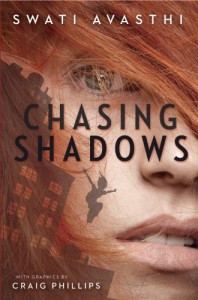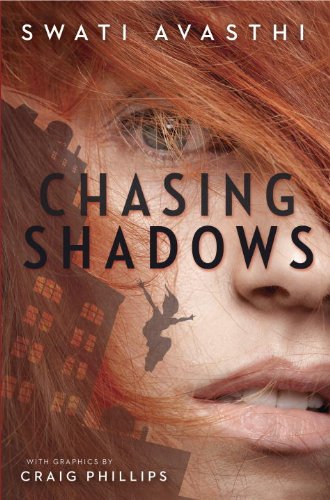By Swati Avasthi, for The Children’s Book Review
Published: October 6, 2013
 CHASING SHADOWS was the second book in a two-book contract. In other words, when Knopf bought my first novel, SPLIT, they also bought another book which hadn’t been written, hadn’t been shown or discussed, not one word or even a solid idea was started when the ink on the contract was dry.
CHASING SHADOWS was the second book in a two-book contract. In other words, when Knopf bought my first novel, SPLIT, they also bought another book which hadn’t been written, hadn’t been shown or discussed, not one word or even a solid idea was started when the ink on the contract was dry.
So, before CHASING SHADOWS was CHASING SHADOWS, when it was still a glimmer in my eye, I got to have a phone call with my editor, Nancy Siscoe, about what book 2 would look like. I pitched her the idea on the phone. I outlined some of the plot – three friends whose friendship is tight and solid – Holly, Corey, and Savitri — splinter when Corey is shot and killed. But here’s the kicker, I wanted to tell part of it as a graphic novel – not that I’d written one before; not that she’d edited one before. I could hear the hesitancy in her voice – it would be, she promised, an ambitious project. But then she said the three words every writer needs to hear, “I trust you.”
I clung to that phrase when I drafted and redrafted and redrafted. And when, after around two years, I still didn’t have anything to show her and I was absolutely stuck, she offered to read it. And it was a mess.
On the phone, she asked a question that amounted to, “what is the story you are trying to tell?” I was trying to translate a moment to the page—the moment when we transform from children to adults and learn that safety is an illusion, that we are all vulnerable. I wanted to capture how violence shakes your world and your friendships, how it can break people altogether.
Perhaps she clung to that, because whenever I lost sight of the work (which I did often as it was a complicated manuscript with, as she put it, “a lot of moving pieces”) she would remind me of what story I was trying to tell – what happens to a friendship after sudden, unexpected violence takes the life of someone you love? “How does this part of the book fit with that?” she would ask.
We went through so many rounds of edits over so many years that I think we were both starting to lose sight by the end. And one day after a 6ish hour phone call, I asked her, “Have you ever spent as much time on any book as you did on this one?” She thought about it before she answered, probably not.
I’ve heard about the glory days – about how there were “real editors” once, how Maxwell Perkins spent time with his writers, helped them through their careers, perfected and shaped books. And I’m sure there is truth to this. But for this book, at this time, I got to live in the glory days of old; I had an editor who shaped and perfected this book with me.
I’m sure there is truth to the idea that editors do so much more than edit today, that their time spent editing is limited. I have no idea what my editor’s day looks like. She deals P&L statements, widows and orphans, end papers, signatures, ISBN numbers etc, etc. And those are the things I understand. There’s a huge part of her job that I don’t know about that she alludes to every once in a while as she makes decisions about the book with designers and marketers. While all of these decisions make has repercussions on the book, I remain blissfully unaware of them, left to work on my next book.
Recently, I was having dinner with some friends and one was talking about how her agent was asking her all the right questions about her manuscript, not directing her to tell a particular story, but helping her realize the vision of her book. I found myself saying, “I think that’s what good editors do; they don’t take over and try to turn your book into something they want. They try to bring out the story you want to tell.”
From a writer’s point of view, a good editor keeps the writer on track and asks the right questions. If they can still do that, then they can still do what they need to do – help translate the writer’s singular vision of the story onto the page for the reader. A good editor is a like a bridge from the writer’s vision to the reader’s desk.
About the Author
Swati Avasthi is an award-winning novelist and creative writing professor based in Minnesota.
To learn more, visit: swatiavasthi.com
Add these books to your collection: CHASING SHADOWS and SPLIT

